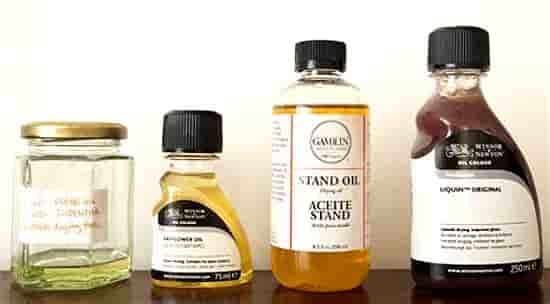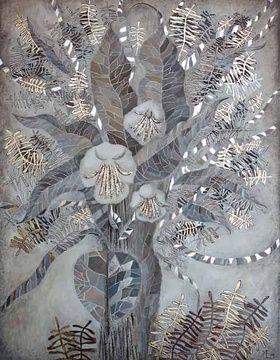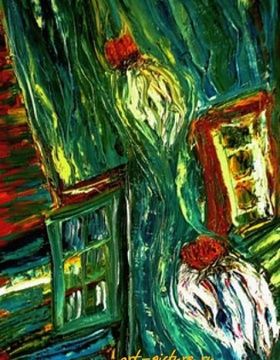
Льняное масло
Льняное масло добывается из семян льна, причем качество получаемого продукта в значительной мере зависит от места возделывания семян, зрелости и чистоты их. Так, масло, полученное из сорных семян, содержит в себе примесь сурепного, рапсового и других масел.
Масло, выжатое без нагревания семян, светло и обладает золотисто-желтым цветом; при горячем же прессовании получается значительно более окрашенное масло, нередко коричне вого цвета с характерным запахом и довольно едким вкусом, лишенное прозрачности вследствие содержащихся в нем посторонних примесей. Свежее масло, полученное холодным прессованием, лишено всякого запаха, который появляется в нем позднее, вероятно, вследствие частичного разложения масла.
Льняное масло, подобно прочим жирам, состоит из углерода, водорода и кислорода. Твердыми жирными кислотами его являются главным образом пальмитиновая и стеариновая, общее содержание которых в одном из образцов голландского масла согласно анализу, произведенному Эйбнером и Шмидингером, равнялось 8,3%. Жидкие кислоты льняного масла состояли из олеиновой, находящейся в нем в количестве 4,5%, линолевых. кислот в количестве 58,8 %, линоленовой - 20,1 % и изолиноленовой - 2,7 %.
Состав льняного масла, как и других растительных масел, отнюдь не является величиной постоянной, как полагали сравнительно еще недавно, а находится в полной зависимости от климата, в котором произрастает растение и из семян которого получено масло.
Это высокой важности открытие принадлежит проф. С. Иванову. Позднейшие анализы льняного масла как нельзя лучше подтверждают истинность заключения проф. Иванова. Так, най дено, что в северных широтах в составе, льняного масла вместо двух видов линоленовых кислот имеется всего лишь один.
Высыхание льняного масла, равно как и прочих жирных масел, обязано присутствию в них трех названных кислот: линолевой, линоленовой и изолиноленовой. Общее количество этих кислот в льняном масле, как видно из приведенных цифр, достигает 81,6%. Этим преобладанием названных кислот в составе льняного масла и объясняется его способность к быстрому высыханию. Льняное масло, нанесенное тонким слоем на стеклянную пластинку, через некоторое время затвердевает во всей своей толще. Если же масло взято в толстом слое, то затвердевание его происходит сначала лишь на поверхности, которая покрывается кожицей, принимающей быстро морщинистый и волнистый вид, так как затвердевшая часть масла под действием кислорода увеличивается в объеме. Это явление особенно характерно для льняного масла. Свежевыжатое холодным путем льняное масло высыхает зимой в 11 дней, летом в 3-6 дней.
Сырое, свежевыжатое льняное масло, как и другие масла, содержит в себе обычно в большем или меньшем количестве слизь, воду и другие посторонние примеси, поступившие в масло при выжимании. Слизистые примеси, состоящие из белковых веществ, могут находиться в совершенно прозрачном масле, мутность масла отнюдь не указывает на присутствие в нем слизи. Вода в свежевыжатом масле может содержаться в количестве до 0,3%, причем прозрачность масла не является также признаком отсутствия ее в масле. Присутствие слизи и воды в масле понижает его качества, и потому они должны быть удаляемы из масла. Очищенное от слизи и воды масло носит название лакового масла.
Льняное масло растворяется легко в эфирных маслах и очень мало в спирту: 1 часть его растворяется в 5 частях кипящего и в 40 частях холодного алкоголя. Масло, долго хранившееся в открытом сосуде и загустевшее, приобретает большую способность растворяться в спирту. Этим раствором пользуются для придачи эластичности спиртовым лакам. При температуре в - 6 гр. Ц масло становится мутным, при - 16 гр. Ц очень густым, а при - 20 гр. Ц застывает вполне; при более сильном охлаждении становится совершенно твердым.
Красильное начало, придающее цвет льняному маслу, состоит из четырех пигментов, в химическом отношении сходных между собою: желтого ксантофила, желтого и синего хлорофила и красного эритрофила. Не все они, однако, присутствуют в масле одновременно. Масло обладает коричневым цветом, если содержит эритрофил и смесь желтого и синего хлорофила, и светложелтым, если в нем преобладает ксантофил. Все эти красящие начала несветопостоянны и потому более или менее быстро разрушаются светом, особенно в присутствии кислорода воздуха. Нагревание масла также сильно обесцвечивает их. Наиболее прочной окраской обладает балтийское масло, которое обесцвечивается с трудом. Сорное льняное семя дает мутное масло с зеленоватым оттенком и слабой способностью к высыханию.
Прибыль и убыль в весе, обычно наблюдающиеся у жирных масел при процессе высыхания, не так велики у льняного масла, как, например, у орехового и макового. Это весьма благоприятно отражается на прочности высохшего слоя льняного масла, которое поэтому менее способно к растрескиванию, чем слои макового и орехового масел.

Льняное масло как связующее вещество красок превосходит по своим качествам все прочие масла.
Масляная живопись прошедших времен исполнена главным образом на льняном масле, и этим в значительной мере объясняется ее прекрасная сохранность. Серьезным недостатком льняного масла является его способность желтеть и темнеть. Высохшая в темноте льняная олифа приобретает красно-коричневый цвет. Отбеленное льняное масло также желтеет, краснеет и темнеет при долгом хранении в темноте. То же происходит и с живописью, исполненной на льняном масле и хранящейся в первом периоде ее высыхания в темноте и в сырости. Под действием прямых солнечных лучей снова возвращается живописи прежний тон, который в тени снова может быть утерян. Старые мастера, писавшие на льняном масле, просушивали всю свежую живопись, во избежание пожелтения и потемнения ее, на солнечном свету.
Позднейшее изучение вопроса пожелтения, наблюдающегося у льняного масла при вышеуказанных условиях, убедило, что причиной пожелтения является одна из составных частей масла, а именно линоленовая кислота, в том случае, если она находится в масле в свободном состоянии. Факт тот, что все масла, содержащие в своем составе названную кислоту, обыкновенно желтеют. Перилловое масло желтеет особенно сильно, так как содержит наибольший процент ее. Эйбнер указывает и средство, как устранить этот недостаток, о чем будет сказано ниже.
Маковое масло
Маковое масло добывается прессованием семян мака. Сорта и цвет семян отражаются на сортах масла, получаемых из них. Белые семена мака считаются более ценными, так как дают большее количество масла, притом лучшего сорта. При холодном прессовании получается почти бесцветное масло, приятного вкуса и лишенное запаха. Масло, получаемое из других сортов семян, имеет темную окраску и представляет низший сорт макового масла.
Маковое масло по своему химическому составу, подобно прочим жирным маслам, на основании теории проф. Иванова, в различных образцах может быть различным. В общем оно значительно отличается от льняного. Твердых жирных кислот насчитывают в нем около 5% всего количества жирных кислот, причем между ними находится лауриновая кислота. Олеиновой кислоты здесь значительно больше, чем в льняном масле, а именно 30 %, линолевой около 60 %, прочих льняно-масляных кислот обыкновенно насчитывается 5%, однако Эйбнер полагает, что маковое масло не содержит вовсе последних, сравнительная же быстрота высыхания его обязана строению глицеридов масла. Вследствие присутствия в маковом масле большого количества олеиновой кислоты его способность к высыханию значительно ниже льняного. Так, если для просыхания слоя льняного масла требуется 3-4 дня, то для слоя макового масла необходимо 6-8 дней, причем и за этот промежуток времени маковое масло не успевает высыхать в той мере, как льняное. Кроме того, линоксин макового масла уступает значительно по качествам линоксину льняного масла.
В процессе высыхания маковое масло вначале весьма увеличивается в весе, но затем значительно теряет в нем, образуя большой процент улетучивающихся веществ. Эта особенность макового масла, свойственная маслам этого типа, дурно отражается на прочности красочного слоя, построенного на нем, так как слой этот легко покрывается трещинами. Лучшим приемом живописи на маковом масле является поэтому однослойная живопись, к которой наиболее располагает это масло, так как оно позволяет писать по-сырому 5-8 дней, и притом придает масляным краскам, тертым на нем, приятную пастозность, а не текучесть, как льняное масло. Многослойная живопись на маковом масле, на основании сказанного, требует большой осторожности и внимательной просушки каждого слоя, особенно опасны в этом случае цинковые белила. Имеются, однако, противники макового масла и в живописи алла прима (Alla prima - сразу, с одного приема). Масляная краска на маковом масле десятилетней давности при пробе ватой, смоченной скипидаром, оставалась на вате. Тот же опыт с льняным маслом не дал следов краски на вате. При высыхания макового масла поверхность его пленки не сморщивается, что так характерно для льняного масла, зато пленка эта, достаточно просохшая, часто размягчается в тени и дает отлип.
Это масло при долгом хранении с доступом воздуха легче прогоркает, чем льняное масло, причем приобретает особый запах и вкус. Маковое масло застывает на холоду при более высокой температуре (-15 гр. Ц), нежели льняное масло.
Ореховое масло
Ореховое масло получается из орехов различных пород деревьев, но главным образом из лесных орехов, зерна которых содержат до 65% масла, относящегося к невысыхающим маслам. Кедровые орехи наших сибирских лесов обильны маслом, применимость которого для живописных целей еще недостаточно исследована. Применение в живописи находит лишь масло грецких (волошских) орехов, но применение это ограничено ввиду дороговизны и сравнительной редкости этого вида масла. Грецкие орехи выдерживают в течение нескольких месяцев, и только тогда приступают к прессованию их, так как из свежих орехов хорошие сорта масла не получаются. Холодное прессование дает слабо окрашенное масло, не имеющее запаха; горячее прессование, которому подвергаются ореховые жмыхи, дает очень низкий сорт масла.
Маслом из грецких орехов, ценившимся за свою белизну и другие качества, пользовались в живописи уже в старину. Леонардо да Винчи в своем известном трактате о живописи так описывает добывание его.
Свежие грецкие орехи очищались сначала от скорлупы и погружались в чистую воду, где покрывающая их кожица намокала и легко снималась с орехов. Затем они переносились в свежую воду, которая менялась несколько раз по замутнении. Через небольшой промежуток времени орехи настолько размяг чались, что при помешивании обращались в молоко, которое затем разливалось в плоские сосуды и выставлялось на солнце. Под влиянием теплоты солнечных лучей чистое светлое масло отстаивалось на поверхности жидкости и собиралось при по мощи ваты, впитывавшей в себя масло.
Ореховое масло при температуре -15 гр. Ц густеет, но твердеет только при -30 гр. Ц. Из твердых жирных кислот оно содержит миристиновую и лауриновую; что касается жидких жирных кислот, то их процентное содержание в масле, по Hazura, таково: олеиновой - 7%, линолевой - 80% и линоленовой - 13%.
Высыхающая способность орехового масла ниже льняного, но превышает таковую же способность макового. Масло холод ного прессования легко отбеливается и делается совершенно бесцветным. Ореховое масло, как и маковое, не желтеет и не темнеет в той степени, как льняное, но легко прогоркает и размягчается после высыхания подобно маковому маслу; что касается до образования трещин, то в этом отношении оно уступает льняному, но безусловно надежнее макового масла, так как слой eго просыхает одновременно во всей толще. Сморщивания масляного слоя при ореховом масле почти не наблюдается, и в этом отношении оно превосходит льняное масло. Не без основания считают, что маковое масло должно быть заменяемо в живописи ореховым.
Подсолнечное масло
Подсолнечное масло добывается из семян подсолнечника. Производство его очень обширно в бывшем СССР, в Западной Европе мало знакомы с ним, и потому в живописи оно не имело еще большого применения. На подсолнечное масло как на материал, пригодный для живописи, указал впервые проф. Ф. Петрушевский.
Сырое подсолнечное масло, выжатое холодным способом, имеет светложелтый цвет, который более или менее легко исчезает на свету и при нагревании. Химический состав его еще мало изучен. [b]Фарион относит подсолнечное масло к полувысыхающим маслам. тоесть масло высыхает частично. При снятии затвердевшей плёнки обнаруживаем, что масло не просохло. Масло это представляет большой интерес для русских живописцев, так как добывается оно главным образом в бывшем СССР, притом в большом количестве, и отличается дешевизной. В последнее время, однако, им заинтересовались и на Западе, где также производятся испытания его пригодности в живописи.
Подсолнечное масло содержит 46% линолевых кислот, 39% олеиновой кислоты и 9% твердых жирных кислот. Эти данные о составе масла, невидимому, близки к истине, так как подтверждаются медленным высыханием подсолнечного масла. Но пока не имеется твердо установленных данных, необходимо, конечно, дальнейшее исследование состава подсолнечного масла. Смешения красок с подсолнечным маслом дали безусловно удовлетворительные результаты, но время высыхания сводило на нет все усилия.
слой подсолнечного масла не морщится при высыхании даже при значительной его толщине; высыхает масло в тонком слое в виде кобальтовой олифы приблизительно в 12 часов. При введении в него смол и эфирных масел оно дает нормальный слой живописи; кроме того, может служить в качестве связующего вещества красок в комбинации с льняным маслом, чем умеряются отрицательные стороны льняного масла.
Суровый приговор, произнесенный Таубером по адресу макового масла, должен относиться и к подсолнечному, если принять во внимание состав последнего. Не следует, однако, упускать из виду того, что маковое масло в XVII столетии с успехом, повидимому, применялось в живописи у голландцев и что со второй половины XIX столетия царил бессистемный метод живописи; при таких условиях маковое масло дало, конечно, худшие результаты, чем оно могло дать. При изменившихся взглядах на состав связующих веществ масляной живописи, когда в них стали вводить смолы и эфирные масла, а также начали пользоваться смесями различных масел, вопрос применения тех или иных из вышеописанных масел в качестве связующих веществ красок остается до сих пор открытым, так как длительного опыта с такими комбинированными связующими веществами в живописи мы еще не имеем.
Для полноты знакомства с различными видами жирных вы сыхающих масел необходимо сказать еще несколько слов о нижеследующих маслах.
Конопляное масло по своим свойствам пригодно лишь в малярном деле, но не в живописи.
Масла сосновых и еловых семян (особенно первое) являются прекрасными заменителями льняного масла. Они желтеют меньше последнего. Солнечным светом выбеливаются легко и вполне. С красками дают хорошую пасту, похожую на пасту, получаемую с маковым маслом. К сожалению, масла эти добы ваются с трудом, почему и цена их высока, особенно масла из елового семени.
Китайские и японские масла - древесное (тунговое) и перилловое - обладают хорошими высыхающими способностями, но в живописи пока применения не имеют и не исследовались в этом направлении.
Олифы
Из веществ, сильно ускоряющих процесс высыхания жир ных масел, в старину были известны лишь свинец и его соединения: глёт, сурик и свинцовые белила, В наше время, кроме свинцовых соединений, служащих делу и поныне, найден ряд и других соединений для названной цели, из которых особенно ценными являются соединения марганца и кобальта. Современ ная техника приготовления олиф располагает, таким образом, весьма разнообразным для этой цели материалом, с помощью которого вырабатываются различные по своим качествам олифы.
Вот перечень наиболее употребительных и наиболее действенных из современных материалов, число которых весьма велико. Наиболее активными из свинцовых соединений являются глёт, сурик и уксуснокислый свинец; из марганцовых: пере кись марганца и борнокислый марганец; из предложенных в недавнее время соединений кобальта - уксуснокислая окись кобальта.
Олифы с помощью названных сушек или, как часто называют их, нерастворимых сикативов получаются двумя главными способами:
- обработкой масел непосредственно металлическими сушками: свинцовыми, марганцовыми и прочими соединениями и
- обработкой масел специальными препаратами, получаемыми из названных сушек и носящими название растворимых сикативов. К олифам, получаемым последним способом, относятся так называемые линолеатные и резинатные олифы.
Олифы первого вида получаются варкой масла при более или менее высокой температуре со свинцовыми, марганцовыми, кобальтовыми и другими соединениями. Одним из видов такого рода олиф может служить обыкновенная свинцовая олифа, приготовление которой сводится к следующему.
Обыкновенная олифа, применяющаяся в малярном деле. Сырое льняное масло без всяких примесей ставится на огонь и нагревается до тех пор, пока на нем не перестанет образовываться пена, которую постоянно снимают. Тогда присыпают к маслу свинцовый глёт, хорошо высушенный (глёт перед этим нагревается в продолжение часа при температуре в 100-120 гр. Ц). На каждые 100 частей по весу масла берут 7-8 (и менее) весовых частей свинцового глёта. По прибавлении глёта масло нагревают до 285гр. Ц в продолжение 3-4 часов, постоянно помешивая. Затем олифа фильтруется.
Марганцовые олифы получаются варкой масла при более или менее высокой температуре с перекисью марганца, с борно кислым марганцем .
Марганцовая олифа.
В лоскуток тонкой материи (батиста) завертывается 1 г сухого борнокислого марганца в порошке, и узелок погружают в стеклянный сосуд, наполненный 500 г масла так, чтобы он был покрыт маслом. После этого сосуд ставится в теплое место с температурой не менее 40 и не выше 100 гр. Ц. В две недели масло готово. При нагревании сосуда в "водной бане" до 100 гр Ц. масло становится готовым ско рее. Если же подвергнуть масло варке, то оно будет готово в 1 час, но получает при этом значительную окраску.
Применяющиеся в позднейшее время в производстве олиф, лаков и т. п. кобальтовые соединения дают быстро высыхающие олифы (в 4-6 часов). Обыкновенно для приготовления кобальтовой олифы пользуются уксуснокислой солью окиси кобальта (ацетата кобальта) - веществом кристаллического строения с красновато-фиолетовой окраской. Приготовление олифы ведется таким образом.
Кобальтовая олифа.
Масло, предназначенное для варки олифы, нагревается до 125 - 180 гр. Ц, после чего в него всыпается понемногу ацетат кобальта, который предварительно должен быть обращен в мелкий порошок. Для лучшего раство рения ацетата в масле последнее беспрерывно помешивают. По растворении кобальтовой соли олифа готова и подвергается отстаиванию или фильтровке. С течением времени (по прошествии приблизительно двух недель) она теряет свою окраску и становится очень светлой. На каждые 100 весовых частей масла берется от 0,25 до 0,3 весовых частей ацетата.
Химический процесс превращения жирных высыхающих масел при варке их с вышеназванными металлическими соеди нениями в олифе в общих чертах заключается в следующем. Под действием высокой температуры масла в присутствии свинца, марганца и т. п. частично разлагаются, т. е. омыляются, причем, с одной стороны, образуются свободные жирные кислоты (между ними муравьиная, масляная, уксусная и др.), с другой - часть освободившегося глицерина переходит в акролеин - удушливый газ, образующийся при варке масел (и подгорании жиров вообще). Свободные льняномасляные жирные кислоты входят в соединение со свинцом, марганцем и другими сушками, образуя льнянокислый свинец, марганец и пр., которые представляют собой соли жирных кислот льняного масла (мыла), носящие название линолеатов. При варке масла лишь небольшая часть его подвергается разложению, большая же часть и после варки состоит из глицеридов; кроме того, масло содержит в себе небольшое количество свинца, марганца и т. п., т. е. тех сушек, которые были введены в дело.
Линолеаты получают, кроме того, в виде особых препаратов, которые служат для приготовления олиф со слабым нагреванием масла или вовсе без него.
Линолеатные и резинатные олифы.
Для упрощения производства олиф и получения их в менее окрашен ном виде в последнее время часто пользуются применением свинцовых, марганцовых и других линолеатов, которые способны растворяться в масле при невысокой температуре (100-180 гр. Ц) и оказывать сушащее действие на масло. Так как названные препараты растворяются, кроме того, в скипидаре, бензине и т. п., то они часто вводятся в масло и в таком виде Это совершенно избавляет от необходимости нагревать масло, а следовательно, является возможность получать еще более светлые олифы.
Кроме линолеатов существует еще вид препаратов, назы ваемых резинатами (от слова resina - смола), в производстве которых масло заменяется канифолью. Таким образом получаются соли смоляных жирных кислот, или, другими словами, свинцовые, марганцовые и другие мыла абиетиновой кислоты (см. "канифоль").
В зависимости от производства их линолеаты и резинаты могут быть сплавленными и осажденными. В первом случае они получаются сплавлением основании с жирными кислотами льняного масла или смоляными; во втором - осаждением водного раствора натровых солей жирных кислот льняного масла или абиетиновой кислоты с помощью какой-либо растворимой соли свинца, марганца и пр. Сплавленные линолеаты и резинаты имеют вид окрашенных твердых или мягких кусков, а также густой жидкости и, наконец, порошка; осажденные же представляют белый или окрашенный порошок. И те и другие растворяются в масле.
Из применяющихся в наше время линолеатов и резинатов наибольший интерес представляют кобальтовые, так как препараты эти не только придают маслу сушащие способности, но и действуют белящим образом на олифу. Ниже приводится один из способов приготовления резината кобальта.
Сикативы
Сикативами называются специальные препараты, назначение которых заключается в ускорении высыхания жирных масел. По своему составу, а также по назначению они различны. Одни из них служат для приготовления олиф, другие примешиваются в масляные краски во время работы, чтобы заставить их быстрее высыхать. Живопись и малярное дело располагают множе ством сикативов, различных между собою по составу, виду, способам применения и пр. Здесь может быть отведено место лишь описанию важнейших сикативов, применяющихся в живописи.
Все этого рода сикативы можно разделить на следующие группы:
- линолеаты и резинаты, свинцовые, марганцовые, кобальтовые,
- сикативы-помады и
- сикативы-лаки.
Линолеаты и резинаты. К ним относятся препараты, о которых говорилось уже в отделе олиф, применяющиеся для приготовления олиф холодным способом. Сикативы эти представляют растворы линолеатов и резинатов свинца, марганца и кобальта в скипидаре, бензине и т. п. Обыкновенно они богаты металлом и потому, будучи введенными даже в малом количестве, способствуют быстрому высыханию масляных красок.
Опыт установил, что сикативы комбинированного состава, например свинцово-марганцовые, действуют более энергично, нежели свинцовые и марганцовые сикативы. каждый в отдельности. Популярным представителем такого вида сикативов является так называемый сикатив Куртре, фабрикующийся в двух видах: темный сикатив Куртре, содержащий до 30% свинца, и светлый сикатив, который содержит малое количество свинца.
Кобальтовый линолеат составляется таким образом. Ацетат кобальта в количестве 15-20 частей нагревается при температуре в 250-280 гр. Ц в 100 частях льняного масла. В результате получается коричневато-красная липкая масса, которая легко растворяется в масле, скипидаре. Чтобы получить быстро сохнущее масло, достаточно ввести в него 1-2,5% этого вещества.
Резинат кобальта
Приготовление его заключается в сплавлении светлых сортов канифоли с ацетатом кобальта. На 300 г смолы берется 10 г ацетата. Все указанное количество соли кобальта прежде всего тщательно растирается с 200 г канифоли; вслед за тем добавляется сюда же вся остальная ка нифоль, и вся масса сплавляется на огне при постоянном помешивании при температуре 130гр. Ц. По растворении ацетата в еще не остывший сплав вливается такое количество свободного от воды бензина, чтобы резинат и по охлаждении оставался в виде сиропообразной жидкости. Для получения олифы достаточ но прилить в холодное масло 2-3% резината. Сикативы-помады имеют различный состав. Одни из них принадлежат к свинцовым сикативам, другие к марганцовым.
Свинцовые помады приготовляются из водного раствора свинцового сахара и жирного масла. Рецепты их разнообразны. Берут, например, 1 объем концентрированного раствора свинцового сахара (с дистиллированной водой) и смешивают с 2 объемами льняного масла, после чего сюда же прибавляют при постоянном помешивании насыщенный раствор мастики в скипидаре. Полученная помада непрозрачна, но при высыхании становится прозрачной. Помада составляется также из масла и порошка, обезвожен ного нагреванием на огне свинцового сахара.
К помадам относится также "Siccatif en pate", который при надлежит к марганцовым сикативам.
Сикативы-лаки получаются растворением твердых смол в эфирных и отчасти жирных скоро высыхающих маслах. Таковы: гаарлемский сикатив, фламандский сикатив и английский сикатив.
Сикативы этого типа состоят часто из твердых смол и бы стросохнущих эфирных масел. Затвердевание масляных красок в их присутствии объясняется главным образом быстрым улетучиванием эфирных масел, заключающихся в них, после чего смолы сикативов, не растворяющиеся в масле красок, твердеют и придают живописи сухой вид. Сикативы-лаки по существу своему являются, таким образом, ложными сикативами (особенно характерен в этом отношении гаарлемский сикатив), не действующими на масло, подобно свинцовым, марганцовым и другим сикативам, а вводящими в него смолы, которые мало или совсем не растворяются в холодном масле и потому чужды масляному слою красок.
Французский скипидар.Французский скипидар также относится к средствам, ускоряющим высыхание масляных красок, так как содействует окислению масла (имеет, кроме того, свойство выбеливать при высыхании смешанные с ним лаки и масла). Особенно сильно сушит сгущенный на воздухе скипидар, имеющий темную окраску, но он темнит живопись. Большое количество скипидара, введенного в масляные краски, делает их матовыми.
Надо иметь в виду, что каждому из сикативов присуща определенная сушащая сила. И потому они должны вводиться в масло или краски хотя и в достаточном, но вместе с тем лишь в необходимом количестве, так как увеличенная порция сикатива не может оказывать никакого действия на дальнейшее ускорение высыхания красок или масел, а насыщает их лишь вредными для него веществами
Предосторожности эти тем более необходимы, что многие из сикативов, особенно олиф, содержат в себе большой процент металлов. Вот почему, например, введение в живопись олиф, приготовленных для малярных целей, совершенно недопустимо.
Не следует упускать из виду и того, что масляная живопись без примеси к краскам искусственных сушек хотя и высыхает медленно, зато долгое время сохраняет эластичность и прочность слоя; при введении же в живопись сикативов, особенно в большом количестве, процесс высыхания ее настолько ускоряется, что появляется и преждевременная старость и ветхость ее. Мастера эпохи Возрождения, создавшие прекрасные образцы масляной живописи, отнюдь не злоупотребляли сикативами.
Средства, замедляющие высыхание масла и масляных красок
При отсутствии дневного света и притока воздуха жирные масла не высыхают; в том же случае, если имеется лишь доступ воздуха к маслу, но совершенно отсутствует свет, процесс высыхания их в значительной мере замедляется. Этим обстоятельством можно пользоваться для продолжительного письма масляными красками "по-сырому". Рекомендуется для названной цели закрывать живопись после окончания работы щитом, непроницаемым для света, помещая его на очень близком расстоянии от поверхности картины. Масляные краски без вреда для них долгое время остаются подвижными, и потому является возможность писать продолжительное время по-сырому. Практикующееся же у художников обыкновение закрывать живопись после дневной работы куском материи или поворачивать ее лицом к стене и оставлять продолжительное время в таком положении нельзя считать нормальным, так как это дурно отражается на просыхании живописи, причем она темнеет и желтеет тем сильнее, чем больше воздух помещения насыщен водяными парами.
Замедляется высыхание масляных красок также при примешивании к ним веществ, поглощающих кислород воздуха. Таковыми являются некоторые из растительных эфирных масел, которые лишь отчасти улетучиваются, а главным образом окисляются за счет кислорода воздуха и переходят в вещества смолистые. Сюда относятся: розмариновое, спиковое, лавендуловое и гвоздичное масла, а также масло, получаемое перегонкой копайского бальзама, который также задерживает высыхание масляных красок и придает им, кроме того, некоторую смолистость. Розмариновое, спиковое, лавендуловое и гвоздичное масла по составу своему занимают среднее место между французским скипидаром и жирными высыхающими маслами, так как кроме углеводородов они содержат в себе кислородные соединения.
Розмариновое масло получается из кустарникового растения розмарина. Лучшими сортами его является французское масло, представляющее бесцветную или слабо окрашенную зеленоватую жидкость с камфарным запахом, кипящую при 150-180 гр. Ц.
Спиковое масло получается из растения лаванды (Lavendula spica), растущего в Южной Франции. Имеет желтый цвет и запах камфары и лаванды, кипит при 166-250 гр. Ц. Лавендуловое масло, получающееся из цветов ла ванды, имеет желтоватый или зеленоватый цвет и приятный запах. Большая составная часть его способна омыляться. Гвоздичное масло (Oleum caraphyllorum) получается из гвоздичного дерева, растущего на Филиппинских островах и Мадагаскаре. Сильно окрашено, сохнет очень медленно, кипит при 150-260 гр. Ц. Применяется также в живописи по фарфору.
Масло копайского бальзама получается дистилляцией из хороших сортов копайского бальзама. Подобно скипидару, представляет смесъ углеводородов ряда терпенов. Кипит при высокой температуре, при обыкновенной не улетучивается, а поглощает кислород воздуха и осмоляется. Получающийся при этом продукт осмоления, в противоположность линоксину жирных высыхающих масел, совершенно растворяется в спирту; кроме того, обладает большой хрупкостью, что заставляет пользоваться им в умеренном количестве. Может служить в качестве картинного, т. е. заключительного, лака. Задерживает высыха ние масляных красок и действует на слой их подобно копайскому бальзаму (см. "Копайский бальзам"). При употреблении этих средств необходимо иметь в виду, что, будучи введенными в большом количестве, они становятся вредными масляному слою. Наиболее безопасно вводить их в масляные краски, тертые на льняном масле, но отнюдь не на маковом и ему подобных маслах. Примесь к масляным краскам невысыхающих масел растительных и минеральных совершенно недопустима.


























